Congenital Malformations in Sea Turtles: Puzzling Interplay between Genes and Environment
Abstract
Simple Summary
Abstract
1. Introduction
2. Pigmentation Disorders
3. Craniofacial Disorders
3.1. Head
3.2. Forebrain and Midline Facial Structures
3.3. Eyes
3.4. Nares
4. Skeletal Defects
4.1. Spine
4.2. Bones
4.3. Limbs and Digits
5. Carapace Defects
6. Schistosomus Reflexus Syndrome
7. Discussion
8. Concluding Remarks
Supplementary Materials
Author Contributions
Funding
Institutional Review Board Statement
Data Availability Statement
Acknowledgments
Conflicts of Interest
References
- Ujházy, E.; Mach, M.; Navarová, J.; Brucknerová, I.; Dubovický, M. Teratology—Past, present and future. Interdiscip. Toxicol. 2012, 5, 163–168. [Google Scholar] [CrossRef] [PubMed]
- Gist, D.H.; Jones, J.M. Sperm storage within the oviduct of turtles. J. Morphol. 1989, 199, 379–384. [Google Scholar] [CrossRef]
- Rostal, D.C.; Robeck, T.R.; Owens, D.W.; Kraemer, D.C. Ultrasound imaging of ovaries and eggs in Kemp’s Ridley sea turtles (Lepidochelys kempi). J. Zoo Wildl. Med. 1990, 21, 27–35. Available online: http://www.jstor.org/stable/20095016 (accessed on 1 February 2021).
- Rostal, D.C. Reproductive physiology of the ridley sea turtle. In Biology and Conservation of Ridley Sea Turtles; Plotkin, P.T., Ed.; Johns Hopkins University Press: Baltimore, MD, USA, 2007; pp. 151–165. [Google Scholar]
- Spotila, J.R. Sea Turtles: A Complete Guide to Their Biology, Behavior, and Conservation; Johns Hopkins University Press: Baltimore, MD, USA, 2004; p. 240. [Google Scholar]
- Jensen, M.P.; Abreu-Grobois, F.A.; Frydenberg, J.; Loeschcke, V. Microsatellites provide insight into contrasting mating patterns in arribada vs. non-arribada olive ridley sea turtle rookeries. Mol. Ecol. 2006, 15, 2567–2575. [Google Scholar] [CrossRef] [PubMed]
- Van de Merwe, J.P.; Hodge, M.; Whittier, J.M.; Ibrahim, K.; Lee, S.Y. Persistent organic pollutants in the green sea turtle Chelonia mydas: Nesting population variation, maternal transfer, and effects on development. Mar. Ecol. Prog. Ser. 2010, 403, 269–278. [Google Scholar] [CrossRef]
- Andrews, R. Patterns of embryonic development. In Reptilian Incubation: Environment, Evolution and Behaviour; Deeming, C., Ed.; Nottingham University Press: Nottingham, UK, 2004; pp. 75–102. [Google Scholar]
- Plotkin, P. Nomadic behaviour of the highly migratory olive ridley sea turtle Lepidochelys olivacea in the eastern tropical Pacific Ocean. Endanger Species Res. 2010, 13, 33–40. [Google Scholar] [CrossRef]
- Kaska, Y.; Downie, R. Embryological development of sea turtles (Cheloniamydas, Carettacaretta) in the Mediterranean. Zool. Middle East 1999, 19, 55–69. [Google Scholar] [CrossRef]
- Miller, J.D. Embryology of marine turtles. In Biology of the Reptilia; Gans, C., Northcutt, R.G., Ulinsky, P., Eds.; Academic Press: New York, NY, USA, 1985; pp. 269–328. [Google Scholar]
- Miller, J.D.; Mortimer, J.A.; Limpus, C.J. A Field Key to the Developmental Stages of Marine Turtles (Cheloniidae) with Notes on the Development of Dermochelys. Chelonian Conserv. Biol. 2017, 16, 111–122. [Google Scholar] [CrossRef]
- Bárcenas-Ibarra, A.; De la Cueva, H.; Rojas-Lleonart, I.; Abreu-Grobois, F.A.; Lozano-Guzmán, R.I.; Cuevas, E.; García-Gasca, A. First approximation to congenital malformation rates in embryos and hatchlings of sea turtles. Birth Defects Res. Part A 2015, 103, 203–224. [Google Scholar] [CrossRef]
- Bárcenas-Ibarra, A. (Biodiversity Conservation and Research NGO, Tamaulipas, Mexico). Personal communication, 2019.
- Martín-del-Campo, R.; Bárcenas-Ibarra, A.; Sifuentes-Romero, I.; Llera-Herrera, R.; García-Gasca, A. Methylation status of the putative Pax6 promoter in olive ridley sea turtle embryos with eye defects: An initial approach. Mech. Dev. 2018, 154, 287–295. [Google Scholar] [CrossRef] [PubMed]
- Bárcenas-Ibarra, A.; Rojas-Lleonart, I.; Lozano-Guzmán, R.I.; García-Gasca, A. Schistosomus reflexus syndrome in olive ridley sea turtles (Lepidochelys olivacea). Vet. Pathol. 2016, 54, 171–177. [Google Scholar] [CrossRef] [PubMed]
- Martín-del-Campo, R.; Bárcenas-Ibarra, A.; Lund, G.; Rodríguez-Ríos, D.; Yong-Villalobos, L.; García-Hernández, J.; García-Gasca, A. Mercury concentration, DNA methylation and mitochondrial DNA damage in olive ridley sea turtle embryos with Schistosomus reflexus syndrome. Vet. Pathol. 2019, 56, 940–949. [Google Scholar] [CrossRef] [PubMed]
- Fuentes, M.M.; Pike, D.A.; Dimatteo, A.; Wallace, B.P. Resilience of marine turtle regional management units to climate change. Glob. Chang. Biol. 2013, 19, 1399–1406. [Google Scholar] [CrossRef] [PubMed]
- Bárcenas-Ibarra, A.; Maldonado-Gasca, A. Malformaciones en Embriones y Neonatos de Tortuga Golfina (Lepidochelys olivacea) en Nuevo Vallarta, Nayarit, México. Vet. Mexico 2009, 40, 371–380. Available online: http://www.scielo.org.mx/pdf/vetmex/v40n4/v40n4a3.pdf (accessed on 20 December 2020).
- Hewavisenthi, S.; Parmenter, C.J. Influence of incubation environment on the development of the flatback turtle (Natator depressus). Copeia 2001, 2001, 668–682. [Google Scholar] [CrossRef]
- Craven, K.S.; Sheppard, S.; Stallard, L.B.; Richardson, M.; Belcher, C.N. Investigating a Link Between Head Malformations and Lack of Pigmentation in Loggerhead sea Turtle Embryos (Caretta caretta) in the Southeastern United States. Herpetol. Notes 2019, 12, 819–825. Available online: https://www.biotaxa.org/hn/article/viewFile/45607/50090 (accessed on 20 December 2020).
- Marcovaldi, M.; Paes-e-Lima, E.; Penteado, R. Albino sea Turtles Hatchlings in Brazil. Mar. Turt. Newsl. 1995, 69, 10. Available online: http://www.seaturtle.org/mtn/archives/mtn69/mtn69p10a.shtml (accessed on 20 December 2020).
- Godfrey, M.H.; Mrosovsky, N. Comment on albino sea turtle hatchlings in Brazil. Mar. Turt. Newsl. 1995, 69, 10–11. Available online: http://www.seaturtle.org/mtn/archives/mtn69/mtn69p10b.shtml (accessed on 20 December 2020).
- Erickson, J.; Kaefer, I.L. Multiple Leucism in a Nest of the Yellow-Spotted Amazon River Turtle, Podocnemis unifilis. Salamandra 2014, 51, 273–276. Available online: http://www.salamandra-journal.com (accessed on 20 December 2020).
- Madeira, F.M.; Patrício, A.R.; Indjai, B.; Barbosa, C.; Regalla, A.; Catry, P.; Rebelo, R. High number of healthy albino green turtles from Africa’s largest population. Mar. Turt. Newsl. 2020, 160, 19. Available online: http://www.seaturtle.org/mtn/archives/mtn160/mtn160-5.shtml (accessed on 20 December 2020).
- Abramyan, J.; Richman, J.M. Recent insights into the morphological diversity in the amniote primary and secondary palates. Dev. Dyn. 2015, 244, 1457–1468. [Google Scholar] [CrossRef] [PubMed]
- Towers, M.; Tickle, C. Growing models of vertebrate limb development. Development 2009, 136, 179–190. [Google Scholar] [CrossRef] [PubMed]
- Pownall, M.E.; Isaacs, H.V. FGF Signalling in Vertebrate Development; Morgan & Claypool Life Sciences: San Rafael, CA, USA, 2010; p. 75. [Google Scholar] [CrossRef]
- Zimm, R.; Bentley, B.P.; Wyneken, J.; Moustakas-Verho, J.E. Environmental causation of turtle scute anomalies in ovo and in silico. Integr. Comp. Biol. 2017, 57, 1303–1311. [Google Scholar] [CrossRef] [PubMed]
- Telemeco, R.S.; Warner, D.A.; Reida, M.K.; Janzen, F.J. Extreme developmental temperatures result in morphological abnormalities in painted turtles (Chrysemys picta): A climate change perspective. Integr. Zool. 2013, 8, 197–208. [Google Scholar] [CrossRef] [PubMed]
- Restrepo, J.; Valverde, R.A. Leucistic Adult Female Green Sea Turtles (Chelonia mydas) Successfully Nesting at Tortuguero, Costa Rica. Mar. Turt. Newsl. 2019, 159, 23–25. Available online: http://www.seaturtle.org/mtn/archives/mtn159/mtn159-5.shtml (accessed on 23 January 2021).
- Van Grouw, H. What colour is that bird? Br. Birds 2013, 106, 17–29. [Google Scholar]
- Brito, J.; Valdivieso-Bermeo, K. First records of leucism in eight species of small mammals (Mammalia: Rodentia). Therya 2016, 7, 483–489. [Google Scholar] [CrossRef]
- Izquierdo, L.; Thomson, R.L.; Aguirre, J.I.; Díez-Fernández, A.; Faivre, B.; Figuerola, J.; Ibáñez-Álamo, D. Factors associated with leucism in the common blackbird Turdus merula. J. Avian Biol. 2018, E01778. [Google Scholar] [CrossRef]
- Møller, A.P.; Mousseau, T.A. Mutation and sexual selection: A test using barn swallows from Chernobyl. Evolution 2003, 57, 2139–2146. [Google Scholar] [CrossRef]
- Phillips, A.R. The Cause of Partial Albinism in a Great-tailed Grackle. Wilson Bull. 1954, 66, 66. Available online: https://sora.unm.edu/sites/default/files/journals/wilson/v066n01/p0066-p0066.pdf (accessed on 20 December 2020).
- Bensch, S.; Hansson, B.; Hasselquist, D.; Nielsen, B. Partial albinism in a semi-isolated population of Great Reed Warblers. Hereditas 2000, 133, 167–170. [Google Scholar] [CrossRef]
- Cieslak, M.; Reissmann, M.; Hofreiter, M.; Ludwig, A. Colours of domestication. Biol. Rev. 2011, 86, 885–899. [Google Scholar] [CrossRef] [PubMed]
- Drenen, J.D. Occurrence of Physical Abnormalities in Caretta caretta at Hobe Sound National Wildlife Refuge, 1987 and 1988. Mar. Turt. Newsl. 1990, 48, 19–20. Available online: http://www.seaturtle.org/mtn/archives/mtn48/mtn48p19.shtml (accessed on 20 December 2020).
- Creuzet, S.E.; Martinez, S.; Le Douarin, N.M. The cephalic neural crest exerts a critical effect on forebrain and midbrain development. Proc. Natl. Acad. Sci. USA 2006, 103, 14033–14038. [Google Scholar] [CrossRef] [PubMed]
- Ornoy, A. Craniofacial malformations and their association with brain development: The importance of a multidisciplinary approach for treatment. Odontology 2020, 108, 1–15. [Google Scholar] [CrossRef]
- Twigg, S.R.F.; Wilkie, A.O.M. New insights into craniofacial malformations. Hum. Mol. Genet. 2015, 24, R50–R59. [Google Scholar] [CrossRef]
- Velo-Antón, G.; Buckley, D.; Daoudi, A.D.; Cordero-Rivera, A. Bicephaly in Salamandra salamandra larvae. Herpetol. Bull. 2007, 101, 31–33. [Google Scholar]
- Wallach, V. Axial Bifurcation and Duplication in Snakes: Part 1: A Synopsis of Authentic and Anecdotal Cases; Maryland Herpetological Society: Annapolis, MD, USA, 2007; Volume 43, p. 57. [Google Scholar]
- Pirozzi, F.; Nelson, B.; Mirzaa, G. From Microcephaly to Megalencephaly: Determinants of Brain Size. Clinical Research. Dialogues Clin. Neurosci. 2018, 20, 267–283. Available online: http://www.dialogues-cns.org (accessed on 20 December 2020). [CrossRef]
- Gilmore, E.C.; Walsh, C.A. Genetic causes of microcephaly and lessons for neuronal development. WIREs Dev. Biol. 2013, 2, 461–478. [Google Scholar] [CrossRef]
- Wang, J.-N.; Ling, F. Zika virus infection and microcephaly: Evidence for a causal link. Int. J. Environ. Res. Public Health 2016, 13, 1031. [Google Scholar] [CrossRef] [PubMed]
- Greene, N.D.E.; Copp, A.J. Neural tube defects. Annu. Rev. Neurosci. 2014, 37, 221–242. [Google Scholar] [CrossRef]
- Detrait, E.R.; George, T.M.; Etchevers, H.C.; Gilbert, J.R.; Vekemans, M.; Speer, M.C. Human neural tube defects: Developmental biology, epidemiology, and genetics. Neurotoxicol. Teratol. 2005, 27, 515–524. [Google Scholar] [CrossRef]
- Bassuk, A.G.; Kibar, Z. Genetic Basis of Neural Tube Defects. Semin Pediatr. Neurol. 2009, 16, 101–110. [Google Scholar] [CrossRef] [PubMed]
- Shiota, K.; Yamada, S. Early pathogenesis of holoprosencephaly. Am. J. Med. Genet. Part C Semin. Med. Genet. 2010, 154, 22–28. [Google Scholar] [CrossRef] [PubMed]
- Chiang, C.; Litingtung, Y.; Lee, E.; Young, K.E.; Corden, J.L.; Westphal, H.; Beachy, P.A. Cyclopia and defective axial patterning in mice lacking Sonic hedgehog gene function. Nature 1996, 383, 407–413. [Google Scholar] [CrossRef]
- Choi, E.; Charles, K.E.; Charles, K.L.; Stewart, K.M.; Morrall, C.E.; Dennis, M.M. Leatherback sea turtle (Dermochelys coriacea) embryo and hatchling pathology in Grenada, with comparison to St. Kitts. Chelonian Conserv. Biol. 2020, 19, 111–123. [Google Scholar] [CrossRef]
- Dennis, J.F.; Kurosaka, H.; Iulianella, A.; Pace, J.; Thomas, N.; Beckham, S.; Williams, T.; Trainor, P.A. Mutations in Hedgehog acyltransferase (Hhat) perturb Hedgehog signaling, resulting in severe acrania-holoprosencephaly-agnathia craniofacial defects. PLoS Genet. 2012, 8, e1002927. [Google Scholar] [CrossRef]
- Petryk, A.; Graf, D.; Marcucio, R. Holoprosencephaly: Signaling interactions between the brain and the face, the environment and the genes, and the phenotypic variability in animal models and humans. WIRES Dev. Biol. 2015, 4, 17–32. [Google Scholar] [CrossRef]
- Cooper, M.K.; Wassif, C.A.; Krakowiak, P.A.; Taipale, J.; Gong, R.; Kelley, R.I.; Porter, F.D.; Beachy, P.A. A defective response to Hedgehog signaling in disorders of cholesterol biosynthesis. Nat. Genet. 2003, 33, 508–513. [Google Scholar] [CrossRef]
- Buglino, J.A.; Resh, M.D. Hhat is a palmitoylacyltransferase with specificity for N-palmitoylation of Sonic Hedgehog. J. Biol. Chem. 2008, 283, 22076–22088. [Google Scholar] [CrossRef]
- Marcucio, R.S.; Cordero, D.R.; Hu, D.; Helms, J.A. Molecular interactions coordinating the development of the forebrain and face. Dev. Biol. 2005, 284, 48–61. [Google Scholar] [CrossRef]
- Kietzman, H.W.; Everson, J.L.; Sulik, K.K.; Lipinski, R.J. The teratogenic effects of prenatal ethanol exposure are exacerbated by Sonic Hedgehog or GLI2 haploinsufficiency in the mouse. PLoS ONE 2014, 9, e89448. [Google Scholar] [CrossRef] [PubMed]
- Aguirre, A.A.; Balazs, G.H. Blood biochemistry values of green turtles, Chelonia mydas, with and without fibropapillomatosis. Comp. Haematol. Int. 2000, 10, 132–137. [Google Scholar] [CrossRef]
- Bloodgood, J.C.; Norton, T.M.; Hoopes, L.A.; Stacy, N.I.; Hernandez, S.M. Comparison of hematological, plasma biochemical, and nutritional analytes of rehabilitating and apparently healthy free-ranging Atlantic green turtles (Chelonia mydas). J. Zoo Wildl. Med. 2019, 50, 69–81. [Google Scholar] [CrossRef] [PubMed]
- De Mello, D.M.; Alvarez, M.C. Health assessment of juvenile green turtles in southern São Paulo State, Brazil: A hematologic approach. J. Vet. Diagn. Investig. 2020, 32, 25–35. [Google Scholar] [CrossRef] [PubMed]
- Da Silva, C.C.; Bianchini, A. Blood cholesterol as a biomarker of fibropapillomatosis in green turtles. Mar. Turt. Newsl. 2019, 158, 16–21. [Google Scholar] [CrossRef]
- Helms, J.A.; Kim, C.H.; Hu, D.; Minkoff, R.; Thaller, C.; Eichele, G. Sonic hedgehog participates in craniofacial morphogenesis and is down-regulated by teratogenic doses of retinoic acid. Dev. Biol. 1997, 187, 25–35. [Google Scholar] [CrossRef]
- Ghyselinck, N.B.; Duester, G. Retinoic acid signaling pathways. Development 2019, 146, dev167502. [Google Scholar] [CrossRef]
- Sucov, H.M.; Evans, R.M. Retinoic acid and retinoic acid receptors in development. Mol. Neurobiol. 1995, 10, 169–184. [Google Scholar] [CrossRef]
- McCaffery, P.J.; Adams, J.; Maden, M.; Rosa-Molinar, E. Too much of a good thing: Retinoic acid as an endogenous regulator of neural differentiation and exogenous teratogen. Eur. J. Neurosci. 2003, 18, 457–472. [Google Scholar] [CrossRef] [PubMed]
- Gongal, P.A.; Waskiewicz, A.J. Zebrafish model of holoprosencephaly demonstrates a key role for TGIF in regulating retinoic acid metabolism. Hum. Mol. Genet. 2008, 17, 525–538. [Google Scholar] [CrossRef] [PubMed]
- Irie, T.; Sugimoto, T.; Ueki, N.; Senoo, H.; Seki, T. Retinoid storage in the egg of reptiles and birds. Comp. Biochem. Physiol. Part B Biochem. Mol. Biol. 2010, 157, 113–118. [Google Scholar] [CrossRef] [PubMed]
- Frutchey, K.P. Plasma Levels of Vitamins A and E in Marine Turtles (CheIonia mydas and Caretta caretta). Master’s Thesis, University of Central Florida, Orlando, FL, USA, 2004. Available online: https://stars.library.ucf.edu/cgi/viewcontent.cgi?article=5579&context=rtd (accessed on 23 January 2021).
- Siebert, J.R. Cyclopia, aprosencephaly, and acardiac twinning: Is hypoxia-ischemia a unifying mechanism? Am. J. Med. Genet. Part A 2007, 143, 3100–3106. [Google Scholar] [CrossRef]
- Hou, L.; Takeuchi, T. Neural crest development in reptilian embryos, studied with monoclonal antibody, HNK-1. Zool. Sci. 1994, 11, 423. [Google Scholar]
- Le Dréau, G.; Martí, E. Dorsal–ventral patterning of the neural tube: A tale of three signals. Dev. Neurobiol. 2012, 72, 1471–1481. [Google Scholar] [CrossRef]
- Betancur, P.; Bronner-Fraser, M.; Sauka-Spengler, T. Assembling neural crest regulatory circuits into a gene regulatory network. Annu. Rev. Cell Dev. Biol. 2010, 26, 581–603. [Google Scholar] [CrossRef]
- Mori-Akiyama, Y.; Akiyama, H.; Rowitch, D.H.; De Crombrugghe, B. Sox9 is required for determination of the chondrogenic cell lineage in the cranial neural crest. Proc. Natl. Acad. Sci. USA 2003, 100, 9360–9365. [Google Scholar] [CrossRef] [PubMed]
- Sekiya, I.; Koopman, P.; Tsuji, K.; Mertin, S.; Harley, V.; Yamada, Y.; Shinomiya, K.; Niguji, A.; Noda, M. Transcriptional suppression of Sox9 expression in chondrocytes by retinoic acid. J. Cell. Biochem. 2001, 81, 71–78. [Google Scholar] [CrossRef]
- Amarilio, R.; Viukov, S.V.; Sharir, A.; Eshkar-Oren, I.; Johnson, R.S.; Zelzer, E. HIF1α regulation of Sox9 is necessary to maintain differentiation of hypoxic prechondrogenic cells during early skeletogenesis. Development 2007, 134, 3917–3928. [Google Scholar] [CrossRef] [PubMed]
- Hu, D.; Marcucio, R.S.; Helms, J.A. A zone of frontonasal ectoderm regulates patterning and growth in the face. Development 2003, 130, 1749–1758. [Google Scholar] [CrossRef]
- Lee, Y.H.; Saint-Jeannet, J.P. Sox9 function in craniofacial development and disease. Genesis 2011, 49, 200–208. [Google Scholar] [CrossRef] [PubMed]
- Young, N.M.; Hu, D.; Lainoff, A.J.; Smith, F.J.; Diaz, R.; Tucker, A.S.; Trainor, P.A.; Schneider, R.A.; Hallgrimsson, B.; Marcucio, R.S. Embryonic bauplans and the developmental origins of facial diversity and constraint. Development 2014, 141, 1059–1063. [Google Scholar] [CrossRef] [PubMed]
- Zaghloul, N.A.; Yan, B.; Moody, S.A. Step-wise specification of retinal stem cells during normal embryogenesis. Biol. Cell 2005, 97, 321–337. [Google Scholar] [CrossRef]
- Kozmik, Z. Pax genes in eye development and evolution. Curr. Opin. Genet. Dev. 2005, 15, 430–438. [Google Scholar] [CrossRef] [PubMed]
- Glaser, T.; Jepeal, L.; Edwards, J.G.; Young, S.R.; Favor, J.; Maas, R.L. PAX6 gene dosage effect in a family with congenital cataracts, aniridia, anophthalmia and central nervous system defects. Nat. Genet. 1994, 7, 463–471. [Google Scholar] [CrossRef] [PubMed]
- Gerth-Kahlert, C.; Williamson, K.; Ansari, M.; Rainger, J.K.; Hingst, V.; Zimmermann, T.; Tech, S.; Guthoff, R.F.; Van Heyningen, V.; FitzPatrick, D.R. Clinical and mutation analysis of 51 probands with anophthalmia and/or severe microphthalmia from a single center. Mol. Genet. Genomic Med. 2013, 1, 15–31. [Google Scholar] [CrossRef]
- Sulik, K.K.; Dehart, D.B.; Rogers, J.M.; Chernoff, N. Teratogenicity of low doses of all-trans retinoic acid in presomite mouse embryos. Teratology 1995, 51, 398–403. [Google Scholar] [CrossRef]
- Kawaguchi, R.; Yu, J.; Honda, J.; Hu, J.; Whitelegge, J.; Ping, P.; Wiita, P.; Bok, D.; Sun, H. A membrane receptor for retinol binding protein mediates cellular uptake of vitamin A. Science 2007, 315, 820–825. [Google Scholar] [CrossRef]
- Williamson, K.A.; FitzPatrick, D.R. The genetic architecture of microphthalmia, anophthalmia and coloboma. Eur. J. Med. Genet. 2014, 57, 369–380. [Google Scholar] [CrossRef]
- Lynn, W.G.; Ullrich, M.C. Experimental production of shell abnormalities in turtles. Copeia 1950, 1950, 253–262. [Google Scholar] [CrossRef]
- Burger, J. Effects of incubation temperature on hatchling pine snakes: Implications for survival. Behav. Ecol. Sociobiol. 1998, 43, 11–18. [Google Scholar] [CrossRef]
- Beleggia, F.; Li, Y.; Fan, J.; Elcioğlu, N.H.; Toker, E.; Wieland, T.; Maumenee, I.H.; Akarsu, N.A.; Meitinger, T.; Strom, M.; et al. CRIM1 haploinsufficiency causes defects in eye development in human and mouse. Hum. Mol. Genet. 2015, 24, 2267–2273. [Google Scholar] [CrossRef] [PubMed]
- Lu, X.; Shao, J.; Li, H.; Yu, Y. Early whole-genome transcriptional response induced by benzo [a] pyrene diol epoxide in a normal human cell line. Genomics 2009, 93, 332–342. [Google Scholar] [CrossRef]
- Kawauchi, S.; Shou, J.; Santos, R.; Hébert, J.M.; McConnell, S.K.; Mason, I.; Calof, A.L. Fgf8 expression defines a morphogenetic center required for olfactory neurogenesis and nasal cavity development in the mouse. Development 2005, 132, 5211–5223. [Google Scholar] [CrossRef] [PubMed]
- Schall, P.Z.; Ruebel, M.L.; Latham, K.E. A new role for SMCHD1 in life’s master switch and beyond. Trends Genet 2019, 35, 948–955. [Google Scholar] [CrossRef] [PubMed]
- Shaw, N.D.; Brand, H.; Kupchinsky, Z.A.; Bengani, H.; Plummer, L.; Jones, T.I.; Samocha, K. SMCHD1 mutations associated with a rare muscular dystrophy can also cause isolated arhinia and Bosma arhinia microphthalmia syndrome. Nat. Genet. 2017, 49, 238. [Google Scholar] [CrossRef]
- Alazami, A.M.; Shaheen, R.; Alzahrani, F.; Snape, K.; Saggar, A.; Brinkmann, B.; Bavi, P.; Al-Gazali, L.I.; Alkuraya, F.S. FREM1 mutations cause bifid nose, renal agenesis, and anorectal malformations syndrome. Am. J. Hum. Genet. 2009, 85, 414–418. [Google Scholar] [CrossRef]
- Lefebvre, V.; Bhattaram, P. Vertebrate skeletogenesis. Curr. Top. Dev. Biol. 2010, 90, 291–317. [Google Scholar] [CrossRef]
- Plymale, H.H.; Jackson, C.G.; Collier, G. Kyphosis in Chrysemys picta yaquia (Testudines: Emydidae) and other turtles. Southwest. Nat. 1978, 23, 457–462. [Google Scholar] [CrossRef]
- Trembath, D.F. Kyphosis of Emydura macquarii krefftii (Testudines:Chelidae) from Townsville, Queensland, Australia. Chelonian Conserv. Biol. 2009, 8, 94–95. [Google Scholar] [CrossRef]
- Turner, G. An instance of kyphoscoliosis in Irwin’s snapping turtle Elseya irwini. Qld. Nat. 2018, 56, 12–17. [Google Scholar]
- Bobyn, J.D.; Little, D.G.; Gray, R.; Schindeler, A. Animal Models of Scoliosis. J. Orthop. Res. 2015, 33, 458–467. [Google Scholar] [CrossRef]
- Williams, E.L.; Harvey, N.C.; Dennison, E.M.; Edwards, C.; Cooper, C. Maternal nutrition and bone health in the offspring. Int. J. Clin. Rheumatol. 2009, 4, 133–145. [Google Scholar] [CrossRef]
- Leal, F.; Cohn, M.J. Loss and re-emergence of legs in snakes by modular evolution of Sonic hedgehog and HOXD enhancers. Curr. Biol. 2016, 26, 2966–2973. [Google Scholar] [CrossRef] [PubMed]
- Kvon, E.Z.; Kamneva, O.K.; Melo, U.S.; Barozzi, I.; Osterwalder, M.; Mannion, B.J.; Tissières, V.; Pickle, C.S.; Plajzer-Frick, I.; Lee, E.A.; et al. Progressive loss of function in a limb enhancer during snake evolution. Cell 2016, 167, 633–642. [Google Scholar] [CrossRef] [PubMed]
- Lettice, L.A.; Devenney, P.; Angelis, C.D.; Hill, R.E. The Conserved sonic hedgehog limb enhancer consists of discrete functional elements that regulate precise spatial expression. Cell Rep. 2017, 20, 1396–1408. [Google Scholar] [CrossRef] [PubMed]
- Lewis, E. A gene complex controlling segmentation in Drosophila. Nature 1978, 276, 565–570. Available online: http://www.ncbi.nlm.nih.gov/pubmed/103000 (accessed on 20 December 2020). [CrossRef] [PubMed]
- Young, J.J.; Grayson, P.; Tabin, C.J. Developmental Biology: Hox timing determines limb placement. Curr. Biol. 2019, 29, R50–R70. [Google Scholar] [CrossRef] [PubMed]
- Lorda-Diez, C.I.; Montero, J.A.; García-Porrero, J.A.; Hurle, J.M. Interdigital tissue regression in the developing limb of vertebrates. Int. J. Dev. Biol. 2015, 59, 55–62. [Google Scholar] [CrossRef]
- Gong, L.; Wang, B.; Wang, J.; Yu, H.; Ma, X.; Yang, J. Polyalanine repeat expansion mutation of the HOXD13 gene in a Chinese family with unusual clinical manifestations of synpolydactyly. Eur. J. Med. Genet. 2011, 54, 108e111. [Google Scholar] [CrossRef] [PubMed]
- Quinonez, S.C.; Innis, J.W. Human HOX gene disorders. Mol. Genet. Metab. 2014, 111, 4–15. [Google Scholar] [CrossRef]
- Schuettengruber, B.; Martinez, A.M.; Iovino, N.; Cavalli, G. Trithorax group proteins: Switching genes on and keeping them active. Nat. Rev. Mol. Cell Biol. 2011, 12, 799–814. [Google Scholar] [CrossRef] [PubMed]
- Hirasawa, T.; Nagashima, H.; Kuratani, S. The endoskeletal origin of the turtle carapace. Nat. Commun. 2013, 4, 2107. [Google Scholar] [CrossRef] [PubMed]
- Moustakas-Verho, J.E.; Zimm, R.; Cebra-Thomas, J.; Lempiäinen, N.K.; Kallonen, A.; Mitchell, K.L.; Hämäläinen, K.; Salazar-Ciudad, I.; Jernvall, J.; Gilbert, S.F. The origin and loss of periodic patterning in the turtle shell. Development 2014, 141, 3033–3039. [Google Scholar] [CrossRef]
- Gilbert, S.F.; Loredo, G.A.; Brukman, A.; Burke, A.C. Morphogenesis of the turtle shell: The development of a novel structure in tetrapod evolution. Evol. Dev. 2001, 3, 47–58. [Google Scholar] [CrossRef]
- Burke, A.C. Development of the turtle carapace: Implications for the evolution of a novel bauplan. J. Morphol. 1989, 199, 363–378. [Google Scholar] [CrossRef]
- Nagashima, H.; Kuraku, S.; Uchida, K.; Ohya, Y.K.; Narita, Y.; Kuratani, S. On the carapacial ridge in turtle embryos: Its developmental origin, function and the chelonian body plan. Development 2007, 134, 2219–2226. [Google Scholar] [CrossRef][Green Version]
- Bentley, B.P.; McGlashan, J.K.; Bresette, M.J.; Wyneken, J. No evidence of selection against anomalous scute arrangements between juvenile and adult sea turtles in Florida. J. Morphol. 2021, 282, 173–184. [Google Scholar] [CrossRef]
- Cortés-Gómez, A.A.; Romero, D.; Girondot, M. Carapace asymmetry: A possible biomarker for metal accumulation in adult olive Ridleys marine turtles? Mar. Pollut. Bull. 2018, 129, 92–101. [Google Scholar] [CrossRef] [PubMed]
- Laughton, K.W.; Fisher, K.R.S.; Halina, W.G.; Partlow, G.D. Schistosomus reflexus syndrome: A heritable defect in ruminants. Anat. Histol. Embryol. 2005, 34, 312–318. [Google Scholar] [CrossRef]
- Gutierrez, C.; Rodríguez, J.L.; Sagrera, M.C.; Cobrera, J.A.; Montoya, J.A. Two cases of schistosomus reflexus and two of omphalocele in the Canarian goat. J. Appl. Anim. Res. 1999, 15, 93–96. [Google Scholar] [CrossRef]
- Molina, V.M.; Oviedo, C.A.; Casado, A.; Arias, M.P. Schistosomus reflexus in a canine: Case report. Rev. Med. Vet. Zoot. 2012, 59, 49–55. Available online: http://www.scielo.org.co/scielo.php?script=sci_arttext&pid=S0120-29522012000100005 (accessed on 20 December 2020).
- Jana, D.; Jana, M. Studies on schistosomus reflexus in indigenous cattle in tropical west Bengal, India. Explor. Anim. Med. Res. 2013, 3, 74–77. Available online: http://animalmedicalresearch.org/Vol.3_Issue-1_June_2013/D%20Jana.pdf (accessed on 20 December 2020).
- Martín del Campo, R.; Sifuentes-Romero, I.; García-Gasca, A. Hox genes in reptile development, epigenetic regulation and teratogenesis. Cytogenet. Genome Res. 2018, 157, 34–45. [Google Scholar] [CrossRef]
- Van Zutphen, A.R.; Lin, S.; Fletcher, B.A.; Hwang, S.-A. A Population-Based Case–Control Study of Extreme Summer Temperature and Birth Defects. Environ. Health Perspect. 2012, 120, 1443–1449. [Google Scholar] [CrossRef]
- Edwards, M.J. Congenital malformations in the rat following induced hyperthermia during gestation. Teratology 1968, 1, 173–178. [Google Scholar] [CrossRef]
- Upfold, J.B.; Smith, M.S.R.; Edwards, M.J. Quantitative study of the effects of maternal hyperthermia on cell death and proliferation in the guinea pig brain on day 21 of pregnancy. Teratology 1989, 39, 173–179. [Google Scholar] [CrossRef] [PubMed]
- Bell, A.W. Consequences of severe heat stress for fetal development. In Heat Stress: Physical Exertion and Environment; Hales, J.R.S., Richards, D.A.B., Eds.; Exerpta Medica, Elsevier Science: Amsterdam, The Netherlands, 1987; pp. 313–333. [Google Scholar]
- Mueller, M.S.; Ruiz-García, N.A.; Garcia-Gasca, A.; Abreu-Grobois, F.A. Best swimmers hatch from intermediate temperatures: Effect of incubation temperature on swimming performance of olive ridley sea turtle hatchlings. J. Exp. Mar. Biol. Ecol. 2019, 519, 151186. [Google Scholar] [CrossRef]
- Singh, S.K.; Das, D.; Rhen, T. Embryonic temperature programs phenotype in reptiles. Front. Physiol. 2020, 11, 1–14. [Google Scholar] [CrossRef]
- Dournon, C.; Bautz, A.; Membre, H.; Lauthier, M.; Collenot, A. Expression of hindlimb abnormalities under rearing temperature effects during the larval development of the salamander Pleurodeles waltl (urodele amphibian). Dev. Growth Differ. 1998, 40, 555–565. Available online: https://onlinelibrary.wiley.com/doi/pdf/10.1046/j.1440-169X.1998.t01-3-00010.x (accessed on 20 December 2020). [CrossRef] [PubMed]
- Fitzsimmons, S.D.; Perutz, M. Effects of egg incubation temperature on survival, prevalence and types of malformations in vertebral column of Atlantic cod (Gadus morhua) larvae. Bull. Eur. Ass Fish Pathol. 2006, 26, 81–86. Available online: https://www.eafp.org/download/2006-Volume26/Issue%202/26_080.pdf (accessed on 20 December 2020).
- Packard, G.C.; Tracy, C.R.; Roth, J.J. The physiological ecology of reptilian eggs and embryos, and the evolution of viviparity within the class reptilian. Biol. Rev. 1977, 52, 71–105. [Google Scholar] [CrossRef]
- Steyermark, A.C.; Spotila, J.R. Effects pf maternal identity and incubation temperature on hatching and hatchling morphology in snapping turtles, Chelydra serpentina. Copeia 2001, 1, 129–135. [Google Scholar] [CrossRef]
- Miller, J.D.; Limpus, C.J.; Godfrey, M.H. Nest site selection, oviposition, eggs, development, hatching, and emergence of loggerhead turtles. In Loggerhead Sea Turtles; Bolten, A.B., Witherington, B.E., Eds.; Smithsonian Institution Press: Washington, DC, USA, 2003; pp. 125–143. [Google Scholar]
- Hawkes, L.A.; Broderick, A.C.; Godfrey, M.H.; Godley, B.J. Investigating the potential impacts of climate change marine turtle population. Glob. Chang. Biol. 2007, 13, 923–932. [Google Scholar] [CrossRef]
- Hawkes, L.A.; Broderick, A.C.; Godfrey, M.H.; Godley, B.J. Climate change and marine turtles. Endang. Species Res. 2009, 7, 137–154. Available online: http://www.int-res.com/articles/esr2009/7/n007p137.pdf (accessed on 20 December 2020). [CrossRef]
- Fuentes, M.M.P.B.; Maynard, J.A.; Guinea, M.; Bell, I.P.; Werdell, P.J.; Hamann, M. Proxy indicators of sand temperature help Project impacts of global warming on sea turtles in northern Australia. Endang. Species Res. 2009, 9, 33–40. [Google Scholar] [CrossRef]
- Navarro-Sánchez, E. Efecto de la temperatura de incubación y la diferenciación sexual sobre la morfología de crías de tortuga golfina Lepidochelys olivacea. Master’s Thesis, Universidad Nacional Autónoma de México, ICMyL, Sinaloa, Mexico, 2015. [Google Scholar]
- Garcês, A.; Pires, I.; Rodrigues, P. Teratological effects of pesticides in vertebrates: A review. J. Environ. Sci. Health Part B 2020, 55, 75–89. [Google Scholar] [CrossRef] [PubMed]
- Pašková, V.; Hilscherová, K.; Bláha, L. Teratogenicity and embryotoxicity in aquatic organisms after pesticide exposure and the role of oxidative stress. Rev. Environ. Contam. Toxicol. 2011, 211, 25–61. [Google Scholar] [CrossRef]
- Ottolenghi, A.D.; Haseman, J.K.; Suggs, F. Teratogenic effects of aldrin, dieldrin, and endrin in hamsters and mice. Teratology 1974, 9, 11–16. [Google Scholar] [CrossRef] [PubMed]
- Birge, W.J.; Black, J.A.; Westerman, A.G.; Ramey, B.A. Fish and amphibian embryos–A model system for evaluating teratogenicity. Toxicol. Sci. 1983, 3, 237–242. [Google Scholar] [CrossRef]
- Mhadhbi, L.; Beiras, R. Acute toxicity of seven selected pesticides (Alachlor, Atrazine, Dieldrin, Diuron, Pirimiphos-Methyl, Chlorpyrifos, Diazinon) to the marine fish (Turbot, Psetta maxima). Water Air Soil Pollut. 2012, 223, 5917–5930. [Google Scholar] [CrossRef]
- Weis, J.S.; Weis, P. Pollutants as developmental toxicants in aquatic organisms. Environ. Health Perspect. 1987, 71, 77–85. [Google Scholar] [CrossRef] [PubMed]
- Khan, M.K.A.; Asmatullah. Teratogenic effect of sublethal doses of deltamethrin in mice. Pakistan J. Zool. 2013, 45, 857–864. [Google Scholar]
- Bishop, C.A.; Brooks, R.J.; Carey, J.H.; Ng, P.; Norstrom, R.J.; Lean, D.R.S. Current Issues the Case for a Cause —Effect Linkage between Environmental Contamination and Development in Eggs of the Common Snapping Turtle (Chelydra s. serpentina) from Ontario, Canada. J. Toxicol. Environ. Health 1991, 33, 521–547. [Google Scholar] [CrossRef]
- Bell, B.; Spotila, J.R.; Congdon, J. High incidence of deformity in aquatic turtles in the John Heinz National Wildlife Refuge. Environ. Pollut. 2006, 142, 457–465. [Google Scholar] [CrossRef]
- Anway, M.D.; Skinner, M.K. Epigenetic transgenerational actions of endocrine disruptors. Endocrinology 2006, 147, S43–S49. [Google Scholar] [CrossRef]
- Shi, X.; He, C.; Zuo, Z.; Li, R.; Chen, D.; Chen, R.; Wang, C. Pyrene exposure influences the craniofacial cartilage development of Sebastiscus marmoratus embryos. Mar. Environ. Res. 2012, 77, 30–34. [Google Scholar] [CrossRef] [PubMed]
- Sakai, H.; Ichihashi, H.; Suganuma, H.; Tatsukawa, R. Heavy metal monitoring in sea turtles using eggs. Mar. Pollut. Bull. 1995, 30, 347–353. [Google Scholar] [CrossRef]
- Bezerra, M.F.; Lacerda, L.D.; Costa, B.G.; Lima, E.H. Mercury in the sea turtle Chelonia mydas (Linnaeus, 1958) from Ceará coast, NE Brazil. An. Acad. Bras. Ciên. 2012, 84, 123–128. [Google Scholar] [CrossRef]
- Bezerra, M.; Lacerda, L.; Lima, E.; Melo, M. Monitoring mercury in green sea turtles using keratinized carapace fragments (scutes). Mar. Pollut. Bull. 2013, 77, 424–427. [Google Scholar] [CrossRef]
- Perrault, J.; Wyneken, J.; Thompson, L.J.; Johnson, C.; Miller, D.L. Why are hatching and emergence success low? Mercury and selenium concentrations in nesting leatherback sea turtles (Dermochelys coriacea) and their young in Florida. Mar. Pollut. Bull. 2011, 62, 1671–1682. [Google Scholar] [CrossRef]
- Martín-del-Campo, R.; Bárcenas-Ibarra, A.; Betancourt-Lozano, M.; García-Gasca, A. Presencia de plaguicidas organoclorados en embriones y crías de tortuga golfina con malformaciones congénitas en la playa de anidación El Verde Camacho, Sinaloa, Mexico. In El Uso del Conocimiento de las Tortugas Marinas como Herramienta Para la Restauración de Sus Poblaciones y Habitats Asociados; Cuevas-Flores, E.A., Guzmán-Hernández, V., Guerra-Santos, J., Rivas-Hernández, G.A., Eds.; UNACAR: Ciudad del Carmen, Mexico, 2019; pp. 251–255. [Google Scholar]
- Fuentes, M.M.P.B.; Fish, M.R.; Maynard, J.A. Management strategies to mitigate the impacts of climate change on sea turtle’s terrestrial reproductive phase. Mitig. Adapt. Strateg. Glob. Chang. 2012, 17, 51–63. [Google Scholar] [CrossRef]
- Jourdan, J.; Fuentes, M.M.P.B. Effectiveness of strategies at reducing sand temperature to mitigate potential impacts from changes in environmental temperature on sea turtle reproductive output. Mitig. Adapt. Strateg. Glob. Chang. 2015, 20, 121–133. [Google Scholar] [CrossRef]
- Van de Merwe, J.; Ibrahim, K.; Whittier, J. Effects of nest depth, shading, and metabolic heating on nest temperatures in sea turtle hatcheries. Chelonian Conserv. Biol. 2006, 5, 210–215. [Google Scholar] [CrossRef]
- Wood, A.; Booth, D.T.; Limpus, C.J. Sun exposure, nest temperature and loggerhead turtle hatchlings: Implications for beach shading management strategies at sea turtle rookeries. J. Exp. Mar. Biol. Ecol. 2014, 451, 105–114. [Google Scholar] [CrossRef]
- Hill, J.E.; Paladino, F.V.; Spotila, J.R.; Tomillo, P.S. Shading and watering as a tool to mitigate the impacts of climate change in sea turtle nests. PLOS ONE 2015, 10, e0129528. [Google Scholar] [CrossRef]
- Read, T.C.; Petit, M.; Magnan, M.; Booth, D. Going back to the roots: Finding a strategy for the management of nesting loggerhead sea turtles in New Caledonia. Aust. J. Zool. 2018, 66, 394–400. [Google Scholar] [CrossRef]
- Mortimer, J.A. The influence of beach sand characteristics on the nesting behavior and clutch survival of green turtles (Chelonia mydas). Copeia 1990, 1990, 802–817. [Google Scholar] [CrossRef]
- Lolavar, A.; Wyneken, J. Experimental assessment of the effects of moisture on loggerhead sea turtle hatchling sex ratios. Zoology 2017, 123, 64–70. [Google Scholar] [CrossRef]
- Huerto, B.F. Relationship between Sand Moisture and Hatching Success of Olive Ridley (Lepidochelys olivacea), at Escobilla, Oaxaca. In Proceedings of the Twelfth Annual Workshop on Sea Turtle Biology and Conservation, Jekyll Island, GA, USA, 25–29 February 1992; Volume 361, pp. 162–165. [Google Scholar]
- Özdemir, B.; Türkozan, O. Hatching success of original and hatchery nests of the green turtle, Chelonia mydas, in northern Cyprus. Turk. J. Zool. 2006, 30, 377–381. Available online: https://journals.tubitak.gov.tr/zoology/issues/zoo-06-30-4/zoo-30-4-6-0509-7.pdf (accessed on 20 December 2020).
- Barraza, A.D.; Komoroske, L.M.; Allen, C.D.; Eguchi, T.; Gossett, R.; Holland, E.; Lawson, D.D.; LeRoux, R.A.; Lorenzi, V.; Seminoff, J.A.; et al. Persistent organic pollutants in green sea turtles (Chelonia mydas) inhabiting two urbanized Southern California habitats. Mar. Pollut. Bull. 2020, 153, 110979. [Google Scholar] [CrossRef] [PubMed]
- Brusca, R.C. The Gulf of California: Biodiversity and Conservation; Brusca, R.C., Ed.; University of Arizona Press: Tucson, AZ, USA, 2010; pp. 1–5. [Google Scholar]
- Páez-Osuna, F.; Álvarez-Borrego, S.; Ruiz-Fernández, A.C.; García-Hernández, J.; Jara-Marini, M.E.; Bergés-Tiznado, M.E.; Piñón-Gimate, A.; Alonso-Rodríguez, R.; Soto-Jiménez, M.F.; Frías-Espericueta, M.G.; et al. Environmental status of the Gulf of California: A pollution review. Earth-Sci. Rev. 2017, 166, 181–205. [Google Scholar] [CrossRef]
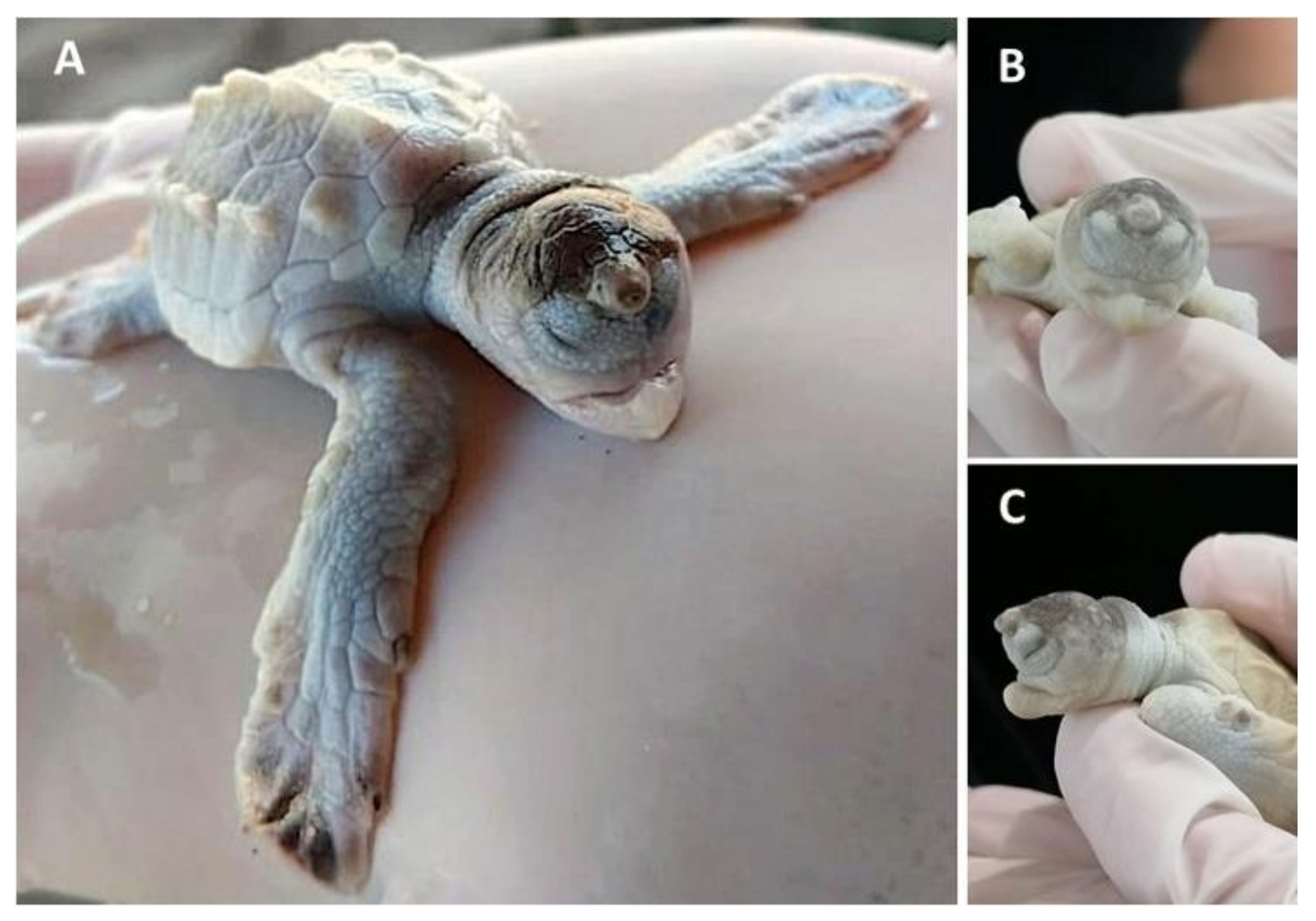
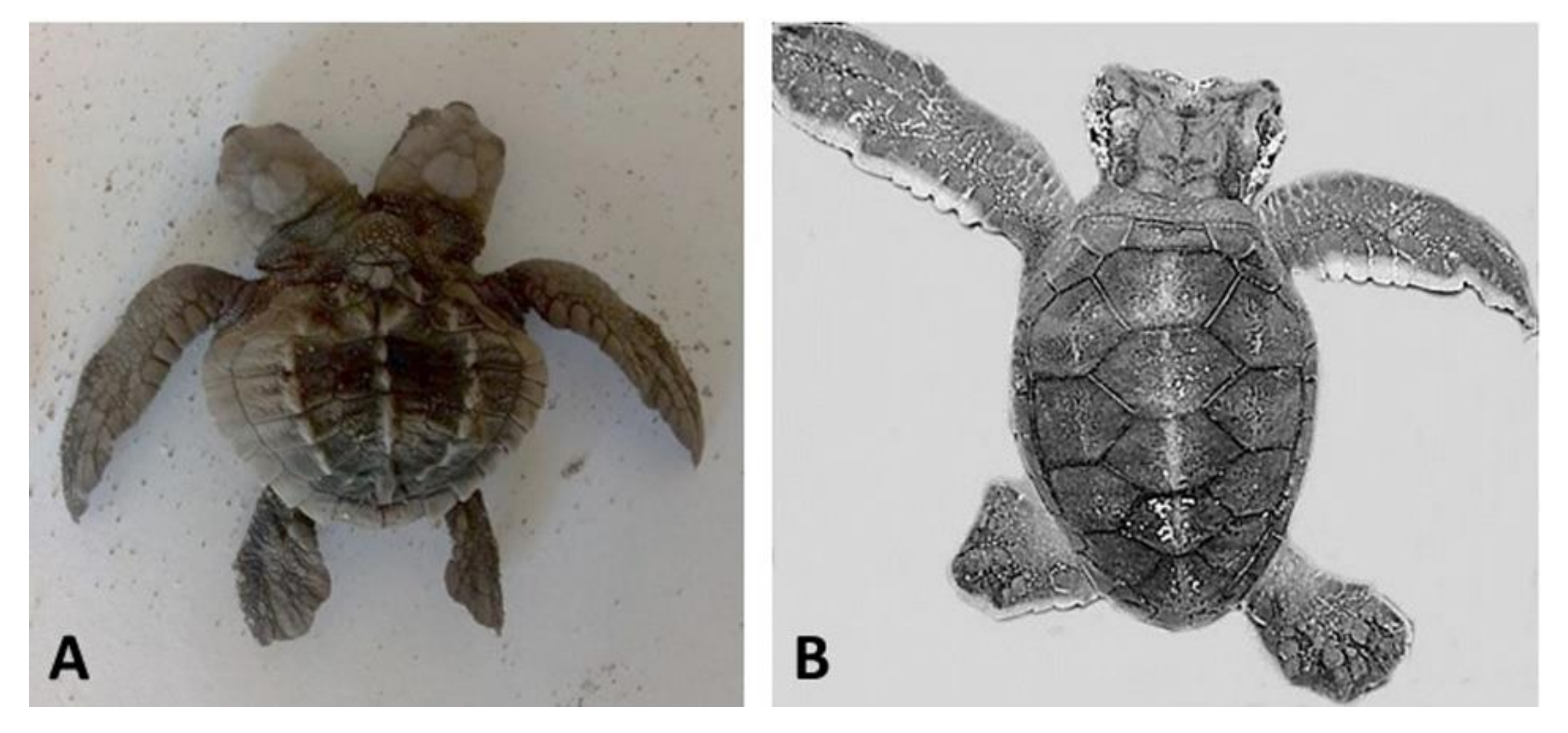
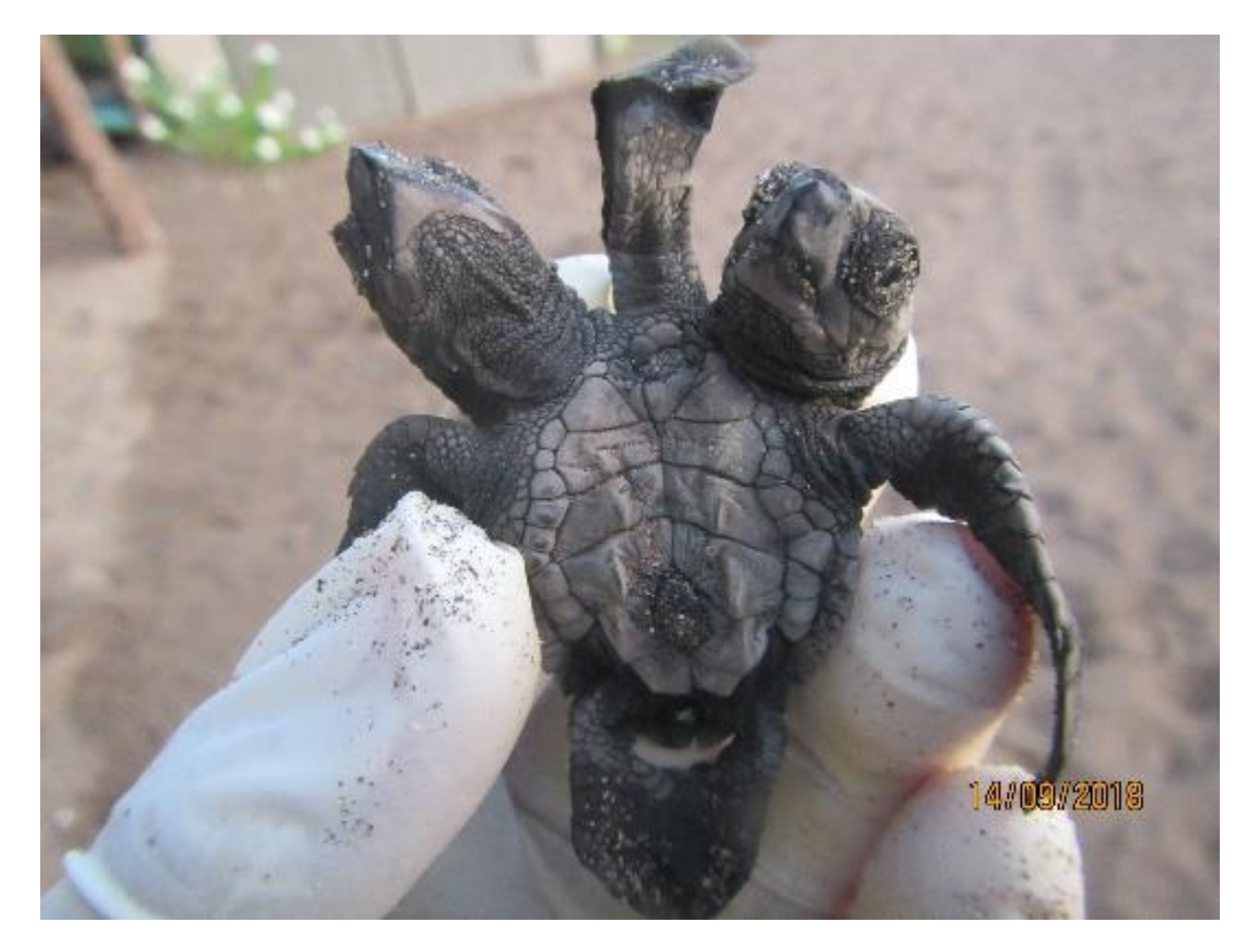
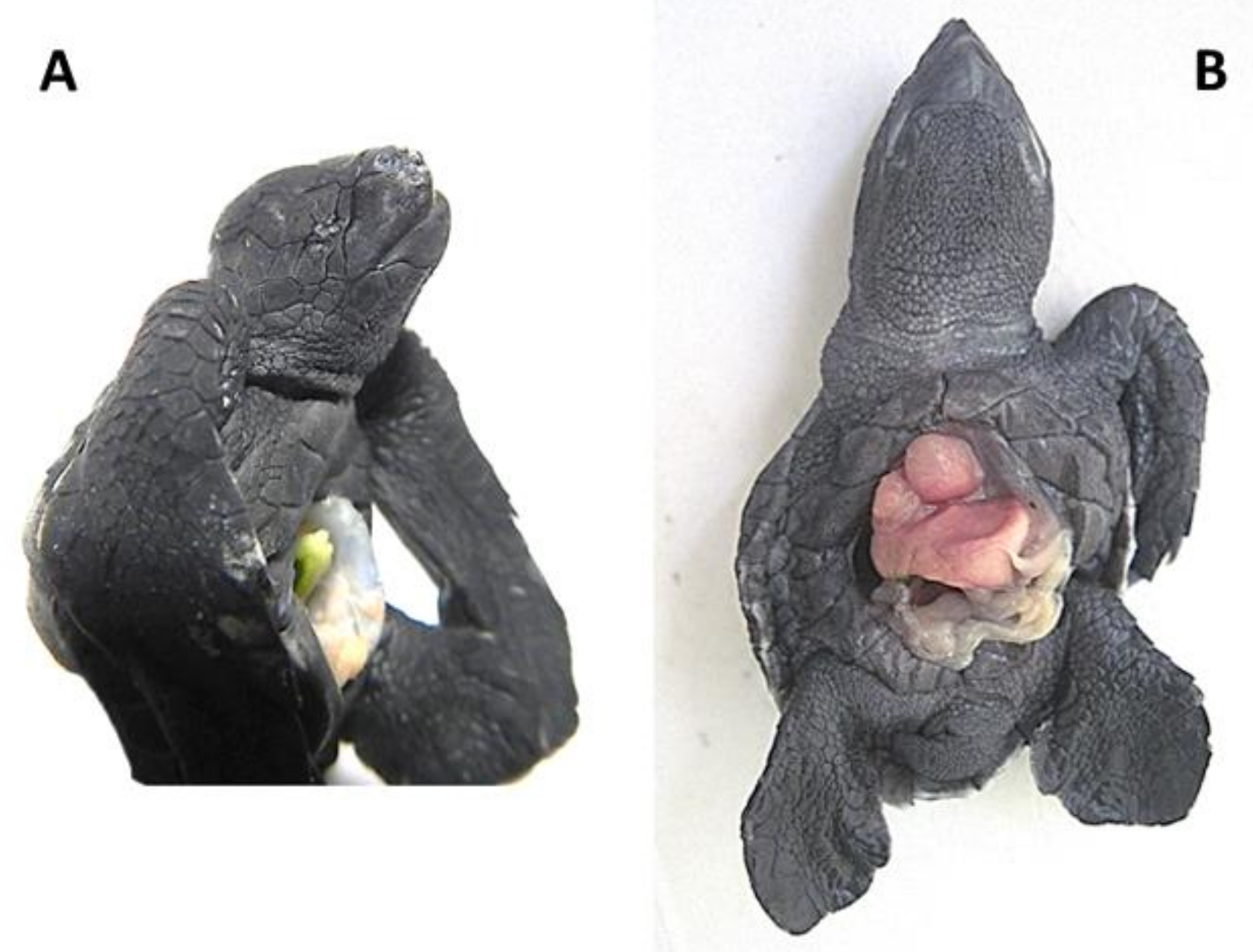
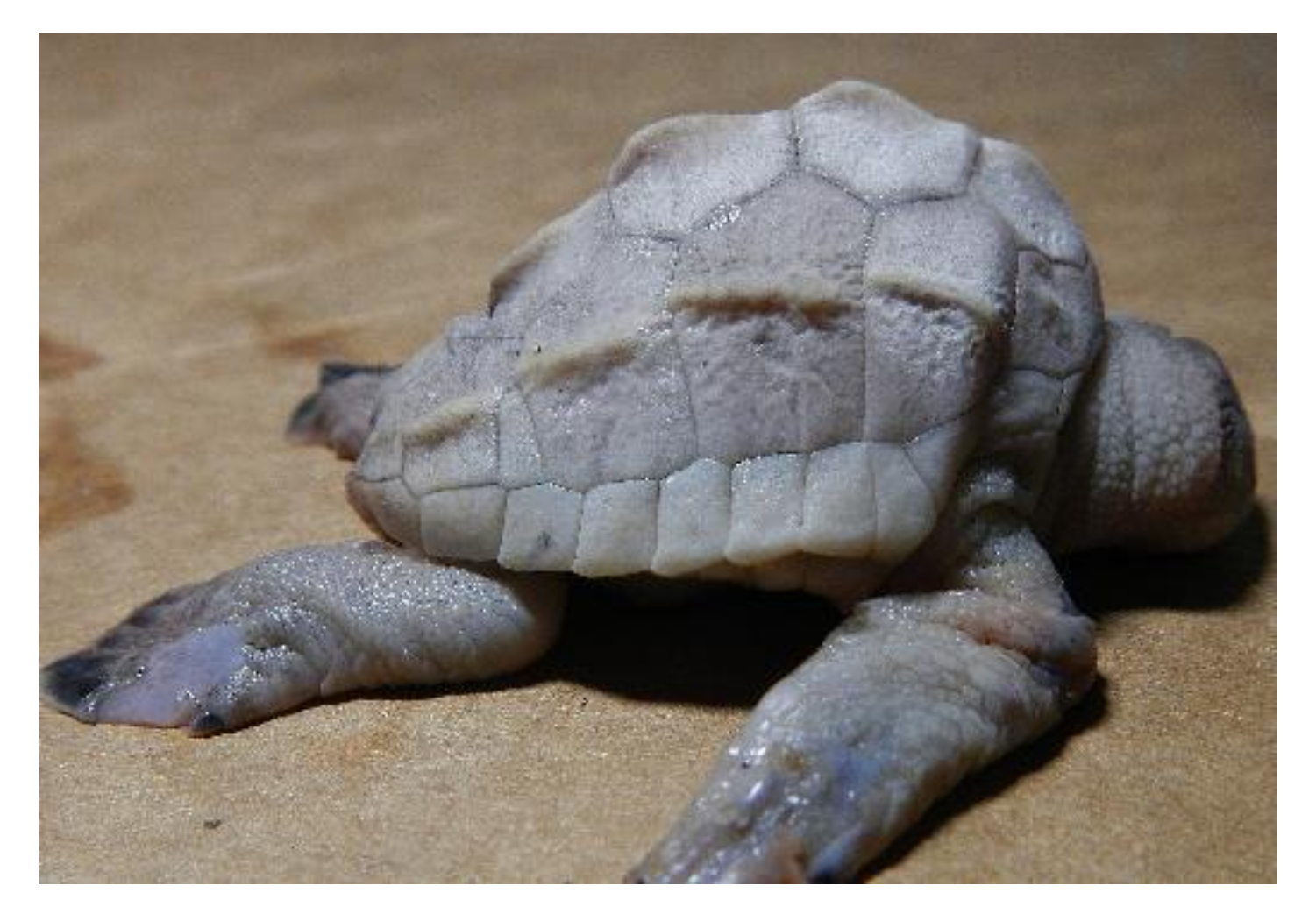
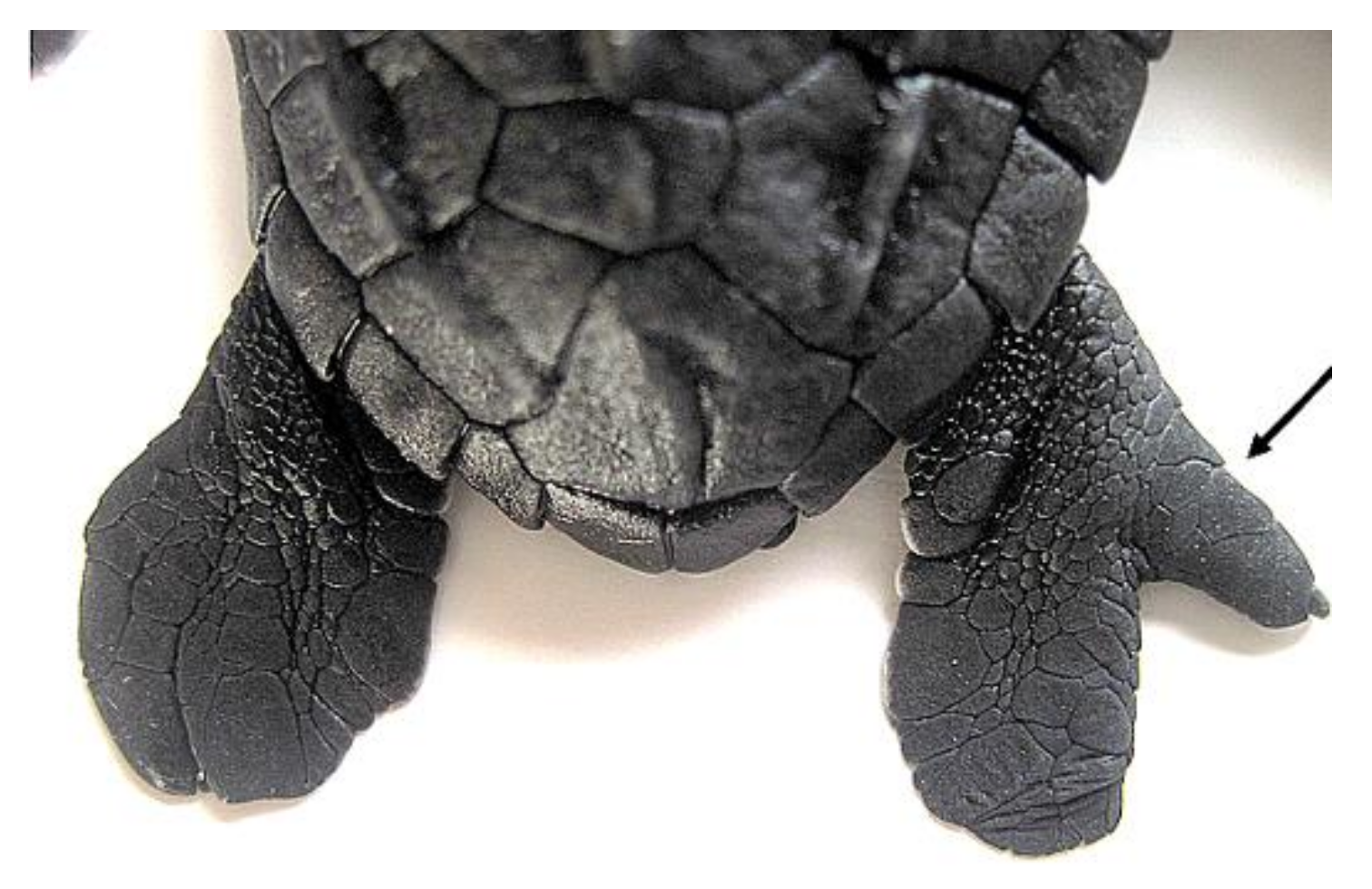
| Developmental Stage | Developmental Process | Morphological Traits | Prevalent Affectations in Sea Turtles Due to Teratogenic Agents |
|---|---|---|---|
1–9 | Fertilisation-Gastrulation-Early Neurulation After fertilisation, the zygote undergoes cleavage to form a blastocyst; the blastula is reorganised into a trilaminar structure. Neurulation initiates | Primitive streak; trilaminar embryonic disc composed of endoderm, ectoderm, and mesoderm; notochordal plate; neural groove; neural folds; head fold | The egg is rich in lipid proteins and is ovoposited in middle gastrula stage; depending on the exposure to a teratogenic factors (such as extreme temperatures), embryonic development may be halted [10,11,12] |
10–14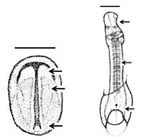 | Neurulation-Somitogenesis The neural plate folds and transforms into the neural tube; somites form from the paraxial mesoderm of the neurulating embryo | Neural tube; somites (up to 17); amnion covers half of the embryo; germ layers; amniotic cap; otic vesicle; first pharyngeal cleft; development of the head, brain, heart, and blood vessels | Gnathoschisis (cleft palate) is the prevalent craniofacial malformation in green, loggerhead and olive ridley sea turtles [13,19] caused by an incorrect fusion of the medial nasal and maxillary prominences and frontonsal mass deriving from mesenchymal and neural crest cells [26] |
15–19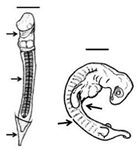 | Somitogenesis-Organogenesis Organised and integrated processes by which embryonic layers transform into tissues and organs | Torsion initiates and completes; embryo on left side; somites (>40); amnion, chorion and yolk sac complete; pharyngeal clefts open and start to close; limb buds develop to form digital plates; blood islands visible; tail elongates; lens visible in the eye | Dysmelia (limb differences) is the most common malformation reported for hawksbill turtles [13]; deviations in the signal centre of the apical ectodermal ridge (AER) cause truncated limb bones [27,28] |
20–25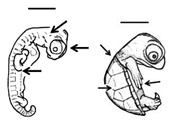 | Early growth All major organs and systems continue to develop and grow | All pharyngeal clefts closed; iris pigmented along posterior border; limbs develop; ribs are visible; carapace develops with scutes; tail equals hindlimbs in length, organs and systems continue to grow | Variation in scute patterns is the most common malformation in hard-shelled sea turtles, and is compatible with life [10,11,13]; hot temperatures and dry conditions may produce scute variations [29,30] |
26–31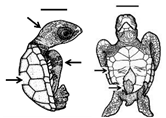 | Late growth-Hatching Organs and systems conclude growth and development; a fully developed sea turtle is ready to hatch | Head and flipper scales present; diameter of yolk decreases (piping stage <10 mm); all organs and systems fully developed; pigmentation is evident; hatching occurs | Leucism (hypopigmentation) has been reported for several species of turtles [13,21,22,23,24,25]; these individuals can survive to adulthood, and remain reproductively active [31] |
Publisher’s Note: MDPI stays neutral with regard to jurisdictional claims in published maps and institutional affiliations. |
© 2021 by the authors. Licensee MDPI, Basel, Switzerland. This article is an open access article distributed under the terms and conditions of the Creative Commons Attribution (CC BY) license (http://creativecommons.org/licenses/by/4.0/).
Share and Cite
Martín-del-Campo, R.; Calderón-Campuzano, M.F.; Rojas-Lleonart, I.; Briseño-Dueñas, R.; García-Gasca, A. Congenital Malformations in Sea Turtles: Puzzling Interplay between Genes and Environment. Animals 2021, 11, 444. https://doi.org/10.3390/ani11020444
Martín-del-Campo R, Calderón-Campuzano MF, Rojas-Lleonart I, Briseño-Dueñas R, García-Gasca A. Congenital Malformations in Sea Turtles: Puzzling Interplay between Genes and Environment. Animals. 2021; 11(2):444. https://doi.org/10.3390/ani11020444
Chicago/Turabian StyleMartín-del-Campo, Rodolfo, María Fernanda Calderón-Campuzano, Isaías Rojas-Lleonart, Raquel Briseño-Dueñas, and Alejandra García-Gasca. 2021. "Congenital Malformations in Sea Turtles: Puzzling Interplay between Genes and Environment" Animals 11, no. 2: 444. https://doi.org/10.3390/ani11020444
APA StyleMartín-del-Campo, R., Calderón-Campuzano, M. F., Rojas-Lleonart, I., Briseño-Dueñas, R., & García-Gasca, A. (2021). Congenital Malformations in Sea Turtles: Puzzling Interplay between Genes and Environment. Animals, 11(2), 444. https://doi.org/10.3390/ani11020444








